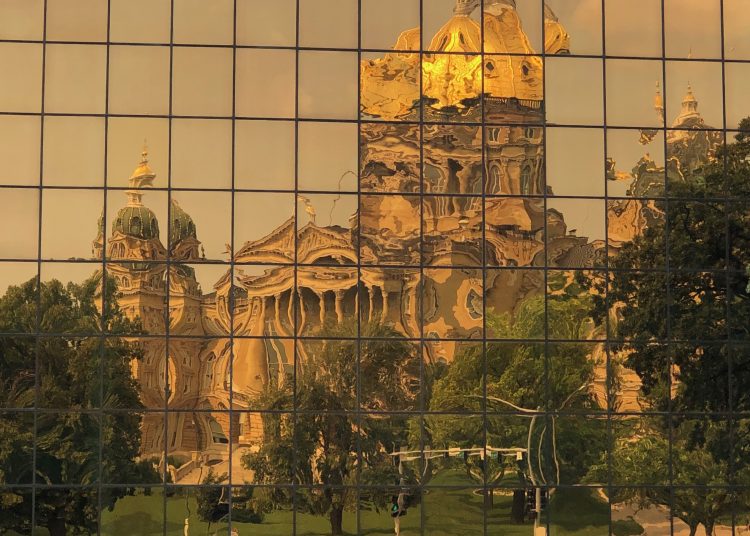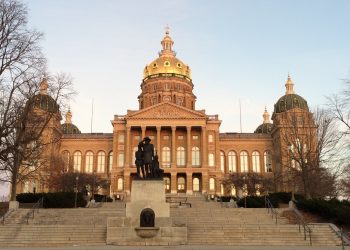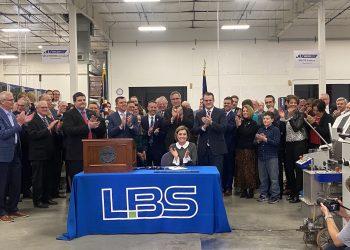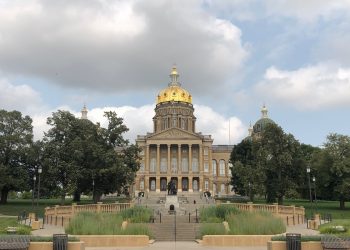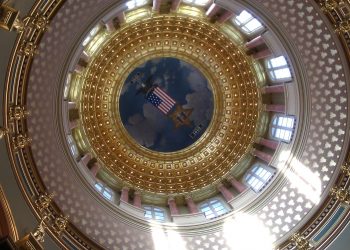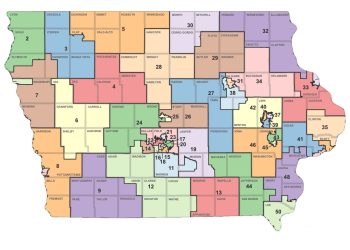DES MOINES, Iowa – The Legislative Services Agency (LSA) released the first redistricting plan on Tuesday with maps for newly drawn Congressional, Iowa Senate, and Iowa House districts.
The Temporary Redistricting Advisory Commission will hold three public hearings to solicit feedback from Iowans about the maps. Afterward, they will submit a report to the Iowa Legislature, who gavels in for a special session on October 5 to consider the first proposed plan.
There are several statutory standards for redistricting that LSA has to consider when drawing the district maps.
There has to be population equity. Iowa’s population, according to the 2020 Census, is 3,190,369 people. The Iowa Code provides that each congressional district must have a population as nearly equal as practicable to the ideal population (the total population of the state as reported in the decennial census divided by, in Iowa’s case, four congressional districts that are to be created. That number is 797,592 people.). Newly drawn congressional districts can’t vary by more than one percent of the ideal population.
The ideal population for each of Iowa’s 50 Senate districts is 63,807 persons and for each of Iowa’s House districts is 31,904 persons. Districts are not to supposed to deviate by more than one percent of the ideal population. According to Iowa law, the Iowa Legislature has the burden of proof to justify any district that varies from the ideal population for that district by more than one percent.
Redistricting by Iowa Code and Constitution is supposed to respect political subdivision. For instance, Article III, Section 37 of the Iowa Constitution states, “…no county shall be divided in forming a congressional district.”
With Iowa Senate and House districts, it is more complicated. The number of cities and counties divided among more than one Senate or House district shall be as small as possible. When there is a choice between dividing local political subdivisions, the more populous subdivisions shall be divided before the less populated except for when a county line divides a city.
The Iowa Constitution and Iowa Code require districts to be contiguous territory. No part of a district can be entirely separated from another part of a district. Districts should be reasonably compact and not irregularly shaped to the extent permitted by natural or political boundaries.
Also, Iowa law prohibits districts from being drawn to favor a political party, an incumbent legislator or member of Congress, or other person or group, or to augment or dilute the voting strength of a language or racial minority group. LSA is prohibited by law from using the addresses of incumbent legislators or members of Congress, political affiliations of registered voters, and previous election results.
Congressional District Map:
No incumbent member of Congress was placed outside of the newly drawn congressional districts, which are considerably different than what Iowa currently has.
Here is the first proposal below:
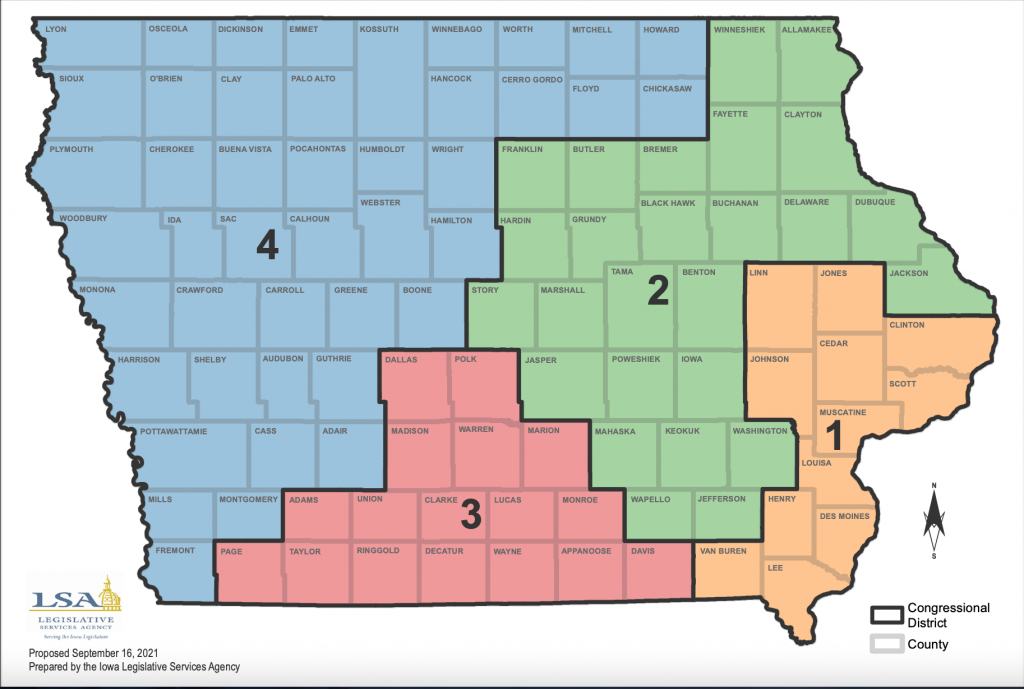
For contrast, below is the current map:

Iowa 1st Congressional District
The proposed new Iowa 1st Congressional District is the smallest in terms of geography. It currently has 20 counties, but the proposed map only has 12. Only Linn and Jones counties remain from the current district county make-up. It has a population of 797,655 people.
Currently, this district has 161,398 registered Democrats and 147,154 registered Republicans giving Democrats an advantage of 14,244 registered voters. Under the proposed map, the district has 180,189 registered Democrat voters and 133,319 registered Republican voters, giving Democrats a 46,897 registered voter advantage.
Iowa’s 1st Congressional District is represented by U.S. Rep. Ashley Hinson, D-Iowa, who resides in Marion in Linn County. This first map puts her at a significant disadvantage with registered voters and a practically new district having only two counties she campaigned in and represented before.
Iowa 2nd Congressional District
Iowa’s 2nd Congressional District gained two counties in the first map from 24 to 26; only eight counties remain from the current district. The proposed district has a population of 797,556.
Currently, Democrats enjoy a voter registration edge of 12,789 people with 160,644 registered voters compared to Republicans with 147,855 registered voters. The new proposed district flips that around. Republicans would have a 9,972 registered voter advantage with 161,716 registered voters compared to Democrats with 151,744.
This map is more favorable to U.S. Rep. Mariannette Miller-Meeks, R-Iowa, who only won the 2020 election by six votes. However, because of the large number of independent voters in the district, it will likely still be considered a swing district. Also, should this map be adopted, her likely Democratic challenger, State Rep. Christina Bohannan, D-Iowa City, would now be in Iowa’s 1st Congressional District. Bohannan could move into the district or run in Iowa’s 1st Congressional District instead and compete against State Senator Liz Mathis, D-Hiawatha, for the Democratic nomination.
Iowa 3rd Congressional District
Iowa’s 3rd Congressional District, instead of inhabiting the southwest quadrant of the state under the new map, will reside in southcentral Iowa. It grew from 16 counties to 17. A congressional district already dominated by the Des Moines Metro will see Polk County make an even greater impact since the district no longer contains Council Bluffs. According to LSA, 797,584 people reside in the district.
Currently, Democrats enjoy a slight voter registration advantage having 3,408 more registered voters than Republicans (177,071 to 173,663). Under the proposed map, that increases to 10,706 with 168,035 Democrats and 157,329 Republicans. However, the district will remain competitive with independent voters.
U.S. Rep. Cindy Axne, D-Iowa, living in West Des Moines, would remain in Iowa’s 3rd Congressional District. In addition, this new map would impact one candidate running for the Republican nomination, former State Rep. Mary Ann Hanusa of Council Bluffs would reside in Iowa’s 4th Congressional District.
Iowa 4th Congressional District
The state’s largest congressional district under the new map just grew larger from 39 counties to 44. It has 797,574 people residing in what would be the new district.
The district will also remain a Republican stronghold. Currently, Republicans enjoy an 81,736 registered voter advantage with 194,261 registered voters compared to the Democrats’ 112,525 registered voters. Under the proposed map, Republicans expand that advantage to 98,224 registered voters with 210,476 registered voters compared to 112,252 registered voters for the Democrats.
U.S. Rep. Randy Feenstra, R-Iowa, who resides in Hull, can expect to win re-election, but he will have an even larger district to travel if this map is approved.
Iowa Senate
Below is LSA’s first proposed Iowa Senate District map:
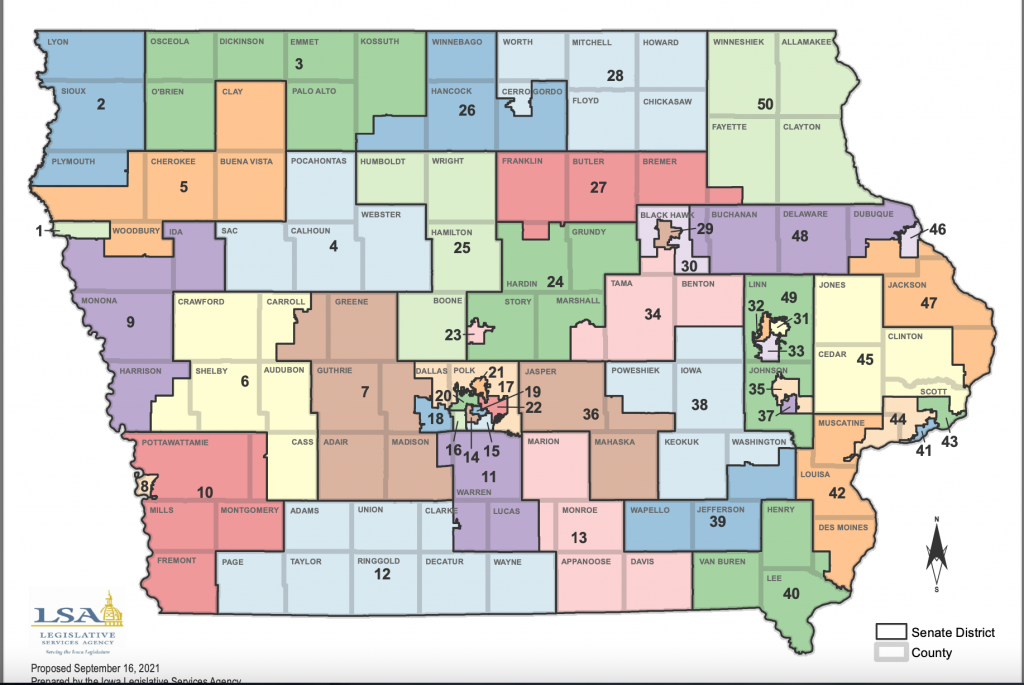
In addition, here is the current map for comparison:
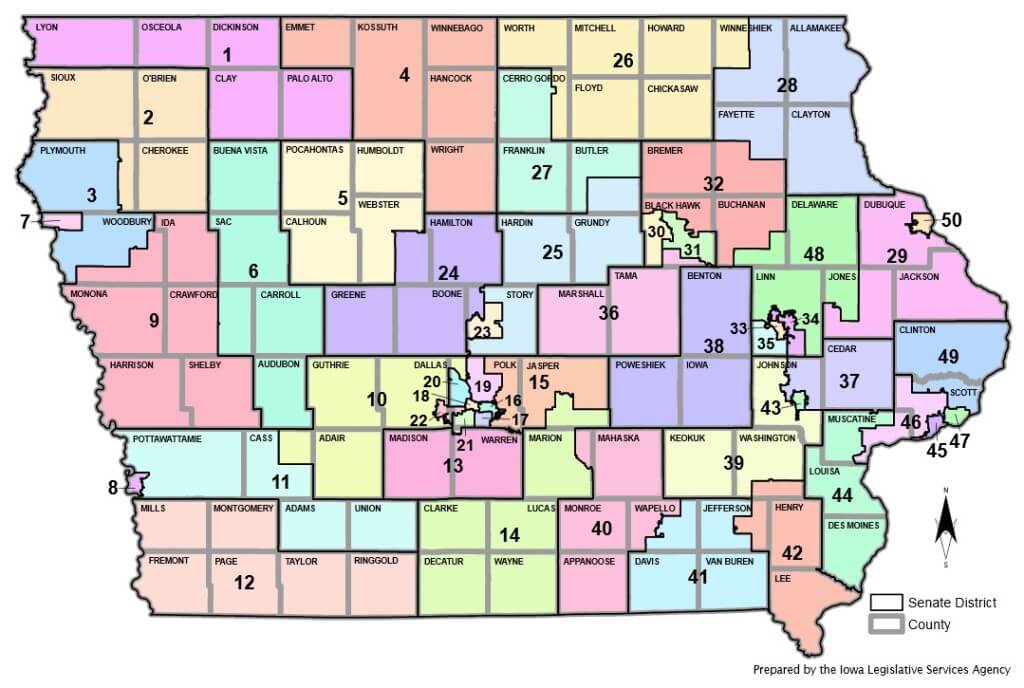
Senate district in urban areas became smaller and more densely populated. Polk County, which contains most of the Des Moines Metro, saw two additional complete districts residing with the county.
Using legislators’ home addresses found either on the legislature’s website or on campaign documentation found at data.iowa.gov, the Iowa Torch found twenty-two incumbents, 44 percent of the chamber, were placed in districts with another incumbent.
The list of districts with incumbents is below with the senators’ current senate district in parenthesis:
- SD 1: State Senator Jackie Smith, D-Sioux City, (SD 7)
- SD 2: State Senator Jeff Taylor, R-Sioux Center, (SD 2)
- SD 3: State Senator Zach Whiting, R-Spirit Lake, (SD 1)
- SD 4: State Senators Tim Kraayenbrink, R-Ft. Dodge, (SD 5) and Jesse Green, R-Harcourt, (SD 24)
- SD 5: Open
- SD 6: State Senators Craig Williams, R-Manning, (SD 6) and Jason Schultz, R-Schleswig, (SD 9)
- SD 7: Open
- SD 8: State Senator Dan Dawson, R-Council Bluffs, (SD 8)
- SD 9: State Senator Jim Carlin, R-Sioux City, (SD 3)
- SD 10: State Senator Mark Costello, R-Imogene, (SD 12)
- SD 11: State Senator Julian Garrett, R-Indianola, (SD 13)
- SD 12: State Senators Tom Shipley, R-Nodaway, (SD 11) and Amy Sinclair, R-Allerton, (SD 14)
- SD 13: Open
- SD 14: State Senator Janet Petersen, D-Des Moines, (SD 18)
- SD 15: State Senator Tony Bisignano, D-Des Moines, (SD 17)
- SD 16: State Senators Claire Celsi, D-West Des Moines, (SD 21) and Sarah Trone Garriott, D-Windsor Heights, (SD 22)
- SD 17: State Senator Zach Nunn, R-Bondurant, (SD 15)
- SD 18: State Senator Jake Chapman, R-Adel, (SD 10) (Updated: Originally had Chapman in SD 7, but he has moved and his address was not updated on the legislative website.)
- SD 19: Open
- SD 20: State Senator Brad Zaun, R-Urbandale, (SD 20)
- SD 21: State Senator Jack Whitver, R-Ankeny, (SD 19)
- SD 22: State Senator Nate Boulton, D-Des Moines, (SD 16)
- SD 23: State Senator Herman Quirmbach, D-Ames, (SD 23)
- SD 24: State Senators Annette Sweeney, R-Alden, (SD 25) and Jeff Elder, R-State Center, (SD 36)
- SD 25: Open
- SD 26: State Senators Dennis Guth, R-Klemme, (SD 4) and Amanda Ragan, D-Mason City, (SD 27)
- SD 27: Open
- SD 28: State Senator Waylon Brown, R-Osage, (SD 26)
- SD 29: Open
- SD 30: State Senators Eric Giddens, D-Cedar Falls, (SD 30) and William Dotzler, D-Waterloo, (SD 31)
- SD 31: Open
- SD 32: State Senators Liz Mathis, D-Hiawatha, (SD 34) and Todd Taylor, D-Cedar Rapids, (SD 35) Note: Mathis is running for Congress. She wasn’t up for re-election in the Iowa Senate in 2022, but since Taylor is placed in the district, she will have to give up her seat if this map is approved.
- SD 33: State Senator Robert Hogg, D-Cedar Rapids, (SD 33)
- SD 34: Open
- SD 35: State Senator Zach Wahls, D-Coralville, (SD 37)
- SD 36: State Senator Ken Rozenboom, R-Oskaloosa, (SD 40)
- SD 37: State Senator Joe Bolkcom, D-Iowa City, (SD 43)
- SD 38: State Senator Dawn Driscoll, R-Williamsburg, (SD 38)
- SD 39: State Senator Adrian Dickey, R-Packwood, (SD 41)
- SD 40: State Senators Jeff Reichmann, R-Montrose, (SD 42)
- SD 41: Open
- SD 42: State Senator Tim Goodwin, R-Burlington, (SD 44)
- SD 43: State Senator Chris Courmoyer, R-Leclaire, (SD 49)
- SD 44: State Senators Jim Lykam, D-Davenport, (SD 45), Mark Lofgren, R-Muscatine, (SD 46), and Roby Smith, R-Davenport, (SD 47)
- SD 45: Open
- SD 46: State Senator Pam Jochum, D-Dubuque, (SD 50)
- SD 47: Open
- SD 48: State Senators Carrie Koelker, R-Dyersville, (SD 29), Craig Johnson, R-Independence, (SD 32), and Dan Zumbach, R-Ryan, (SD 48)
- SD 49: State Senator Kevin Kinney, D-Oxford, (SD 39)
- SD 50: Mike Klimesh, R-Spillville, (SD 28)
Iowa House
Below is the first proposed map for Iowa House Districts submitted by LSA:
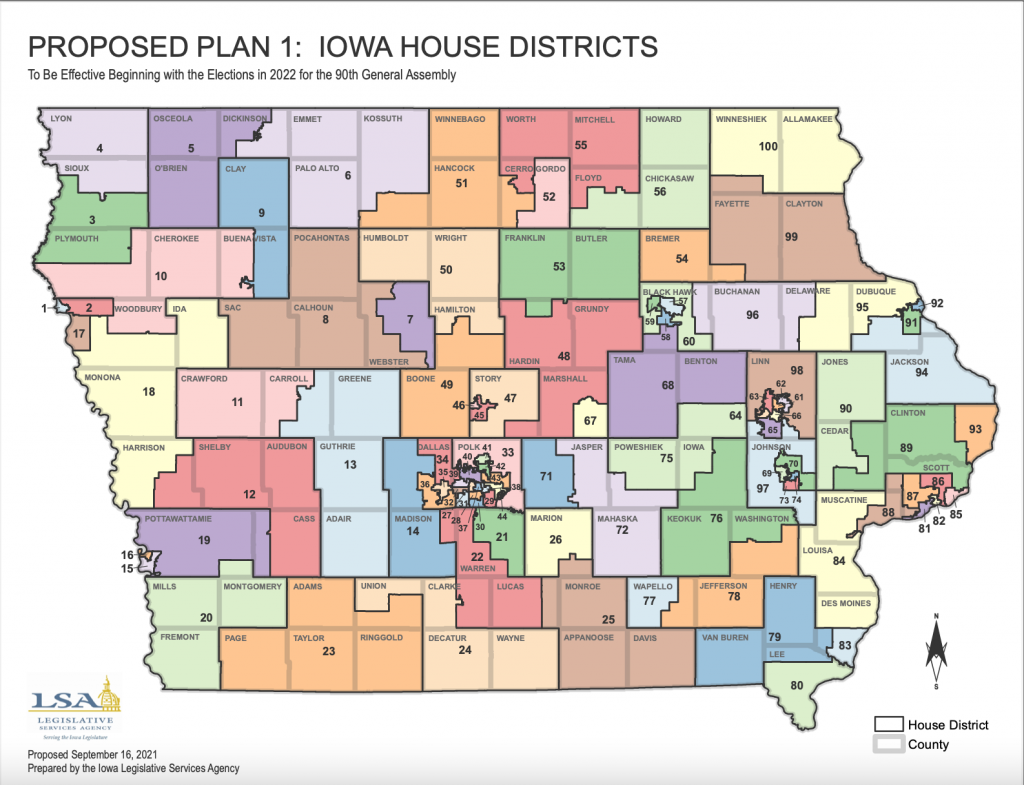
In addition, below is the current map for comparison:

All members of the Iowa House are up for re-election every two years. The Iowa Torch found that 40 out of the 100 incumbents were placed in districts with other incumbents.
The list of districts with incumbents is below with the representatives’ current House district in parenthesis:
- HD 1: State Rep. Chris Hall, D-Sioux City, (HD 13)
- HD 2: State Rep. Steve Hansen, D-Sioux City, (HD 14)
- HD 3: State Reps. Skyler Wheeler, R-Orange City, (HD 4) and Tom Jeneary, R-LeMars, (HD 5)
- HD 4: Open
- HD 5: State Rep. John Wills, R-Spirit Lake, (HD 1)
- HD 6: Open
- HD 7: State Rep. Ann Meyer, R-Ft. Dodge, (HD 9)
- HD 8: State Rep. Mike Sexton, R-Rockwell City, (HD 10)
- HD 9: State Rep. Megan Jones, R-Sioux Rapids, (HD 2)
- HD 10: State Reps. Dennis Bush, R-Cleghorn, (HD 3) and Gary Worthan, R-Storm Lake, (HD 11)
- HD 11: State Rep. Steve Holt, R-Denison, (HD 18)
- HD 12: Open
- HD 13: State Reps. Brian Best, R-Glidden, (HD 12), Ray Sorenson, R-Greenfield, (HD 20), and Phil Thompson, R-Jefferson, (HD 47).
- HD 14: State Rep. Carter Nordman, R-Adel, (HD 19)
- HD 15: State Reps. Brent Siegrist, R-Council Bluffs, (HD 16) and Jon Jacobsen, R-Council Bluffs, (HD 22)
- HD 16: State Rep. Charlie McConkey, D-Council Bluffs, (HD 15)
- HD 17: State Rep. Jacob Bossman, R-Sioux City, (HD 6)
- HD 18: State Rep. Matt Windschitl, R-Missouri Valley, (HD 17)
- HD 19: State Rep. Thomas Moore, R-Griswold, (HD 21)
- HD 20: State Rep. David Sieck, R-Glenwood, (HD 21)
- HD 21: State Rep. Brooke Boden, R-Indianola, (HD 26)
- HD 22: State Rep. Stan Gustafson, R-Cumming, (HD 25)
- HD 23: State Rep. Cecil Dolecheck, R-Mount Ayr, (HD 24)
- HD 24: State Rep. Joel Fry, R-Osceola, (HD 27)
- HD 25: Open
- HD 26: State Rep. Jon Thorup, R-Knoxville, (HD 28)
- HD 27: Open
- HD 28: State Rep. Jo Oldson, D-Des Moines, (HD 41)
- HD 29: State Rep. Brian Meyer, D-Des Moines, (HD 33)
- HD 30: State Rep. Bruce Hunter, D-Des Moines, (HD 34)
- HD 31: State Rep. Kristin Sunde, D-West Des Moines, (HD 42)
- HD 32: State Rep. Jennifer Konfrst, D-Windsor Heights, (HD 43)
- HD 33: State Rep. Brian Lohse, R-Bondurant, (HD 30)
- HD 34: Open
- HD 35: State Rep. Kenan Judge, D-Waukee, (HD 44)
- HD 36: Open
- HD 37: State Reps. Ako Abdul-Samad, D-Des Moines, (HD 35) and Marti Anderson, D-Des Moines, (HD 36)
- HD 38: State Rep. Ruth Ann Gaines, D-Des Moines, (HD 32)
- HD 39: State Rep. John Forbes, D-Urbandale, (HD 40)
- HD 40: State Rep. Eddie Andrews, R-Johnston, (HD 39)
- HD 41: Open
- HD 42: State Reps. Michael Bousselot, R-Ankeny, (HD 37) and Garrett Gobble, R-Ankeny, (HD 38)
- HD 43: Open
- HD 44: State Rep. Rick Olson, D-Des Moines, (HD 31)
- HD 45: State Rep. Ross Wilburn, D-Ames, (HD 46)
- HD 46: State Rep. Beth Wessel-Kroeschell, D-Ames, (HD 45)
- HD 47: State Reps. Robert Bacon, R-Slater, (HD 48) and Dave Deyoe, R-Nevada, (HD 49)
- HD 48: Open
- HD 49: Open
- HD 50: Open
- HD 51: State Reps. Henry Stone, R-Forest City, (HD 7) and Terry Baxter, R-Garner, (HD 8)
- HD 52: State Rep. Sharon Steckman, D-Mason City, (HD 53)
- HD 53: State Reps. Pat Grassley, R-New Hartford, (HD 50) and Shannon Latham, R-Sheffield, (HD 54)
- HD 54: Open
- HD 55: State Rep. Jane Bloomingdale, R-Northwood, (HD 51)
- HD 56: State Rep. Todd Prichard, D-Charles City, (HD 52)
- HD 57: State Reps. Timi Brown-Powers, D-Waterloo, (HD 61) and RasTafari Smith, D-Waterloo, (HD 62)
- HD 58: Open
- HD 59: State Rep. Bob Kressig, D-Cedar Falls, (HD 59)
- HD 60: State Reps. Dave Williams, D-Cedar Falls, (HD 60) and Sandy Salmon, R-Janesville, (HD 63)
- HD 61: Open
- HD 62: State Reps. Eric Gjerde, D-Cedar Rapids, (HD 67) and Molly Donahue, D-Cedar Rapids, (HD 68)
- HD 63: State Rep. Art Staed, D-Cedar Rapids, (HD 66)
- HD 64: State Rep. Tracy Ehlert, D-Cedar Rapids, (HD 70)
- HD 65: State Rep. Kristen Running-Marquardt, D-Cedar Rapids, (HD 69)
- HD 66: State Rep. Liz Bennett, D-Cedar Rapids, (HD 65)
- HD 67: State Rep. Sue Cahill, D-Marshalltown, (HD 71)
- HD 68: State Rep. Dean Fisher, R-Montour, (HD 72)
- HD 69: State Rep. Dave Jacoby, D-Coralville, (HD 74)
- HD 70: State Rep. Amy Nielsen, D-North Liberty, (HD 77)
- HD 71: Open
- HD 72: State Reps. David Maxwell, R-Gibson, (HD 76), Dustin Hite, R-New Sharon, (HD 79), and Holly Brink, R-Oskaloosa, (HD 80)
- HD 73: State Rep. Mary Mascher, D-Iowa City (HD 86)
- HD 74: State Rep. Christina Bohannan, D-Iowa City, (HD 85) Note: She is running for Congress.
- HD 75: State Rep. Thomas Gerhold, R-Atkins, (HD 75)
- HD 76: State Rep. Jarad Klein, R-Keota, (HD 78)
- HD 77: State Rep. Cherielynn Westrich, R-Ottumwa, (HD 81)
- HD 78: Open
- HD 79: State Reps. Jeff Shipley, R-Birmingham, (HD 82) and Joe Mitchell, R-Mt. Pleasant, (HD 84)
- HD 80: State Rep. Martin Graber, R-Ft. Madison, (HD 83)
- HD 81: State Reps. Monica Kurth, D-Davenport, (HD 89) and Cindy Winckler, D-Davenport, (HD 90)
- HD 82: Open
- HD 83: State Rep. Dennis Cohoon, D-Burlington, (HD 87)
- HD 84: State Reps. David Kerr, R-Morning Sun, and Mark Cisneros, R-Muscatine, (HD 91)
- HD 85: State Rep. Gary Mohr, D-Bettendorf, (HD 94)
- HD 86: Phyllis Thede, D-Bettendorf, (HD 93)
- HD 87: State Rep. Ross Paustian, R-Walcott, (HD 92)
- HD 88: Open
- HD 89: State Reps. Bobby Kaufmann, R-Wilton, (HD 73) and Norlin Mommsen, R-DeWitt, (HD 97)
- HD 90: State Reps. Steven Bradley, R-Cascade, and Lee Hein, R-Monticello, (HD 96)
- HD 91: State Rep. Lindsay James, D-Dubuque, (HD 99)
- HD 92: State Rep. Charles Isenhart, D-Dubuqe, (HD 100)
- HD 93: State Rep. Mary Lynn Wolfe, D-Clinton, (HD 98)
- HD 94: Open
- HD 95: Open
- HD 96: Open
- HD 97: Open
- HD 98: State Rep. Charlie McClintock, R-Alburnett, (HD 95)
- HD 99: State Reps. Anne Osmundson, R-Volga, (HD 56) and Chad Ingels, R-Randalia, (HD 64).
- HD 100: Michael Bergan, R-Dorchester, (HD 55)
Conclusion:
With this first plan, the Iowa Legislature can only make corrective amendments, so minor tweaks, and then they have to vote the plan up or down. There is already growing opposition to the first plan. The Dallas County Republican Party Central Committee voted unanimously last night to send a letter to the Legislature calling on lawmakers to vote against the first plan. Also, it’s likely lawmakers will be concerned by the number of incumbents pitted against one another.
If they vote against the first plan, LSA will submit a second plan prepared, following the reasons the first plan was disapproved, within 35 days of the first plan being disapproved, and the process is the same except no public hearings are held.
If the Iowa Legislature approves the first plan and Gov. Kim Reynolds signs (by law, the governor can only veto for reasons not in conflict with redistricting standards provided in the Iowa Code). In that case, the process is over unless an application for review is filed with the Iowa Supreme Court by any qualified voter.



